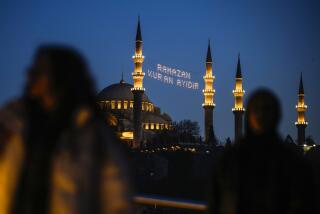Tourists Take Heavy Toll on Turkish Cultural, Natural Treasures : Heritage: Sites on U.N. list of world wonders are close to ruin. Future of ‘Fairy Chimneys’ and travertine terraces are in great jeopardy, experts say.
- Share via
GOREME, Turkey — It took nature millions of years to shape the otherworldly landscapes of Cappadocia and Pamukkale, the only sites in Turkey that appear on the United Nations World Heritage list as both cultural and natural treasures.
It has taken only a few decades for crowds of tourists to bring them close to ruin.
In the valleys of Central Turkey’s Cappadocia region, wind and water have carved 5-million-year-old lava and ash into thousands of cones, pinnacles, needles and spires that local residents call “peri bacalari”--fairy chimneys.
Pamukkale, 165 miles east of Izmir in Western Turkey, is a towering bank of travertine terraces dappled with scalloped pools filled with calcium-rich water fed by hot springs.
The future of both sites is in jeopardy unless action is taken soon to save them, experts say. Pamukkale has a better chance to survive than Cappadocia.
“Cappadocia will be flat in 100 years, maybe a little more,” said Sermin Erden of the Turkish Ministry of Culture. She blames “human erosion.”
Here, Roman Catholic monks in the 4th Century formulated the doctrine of the Trinity, and Christians sought refuge when Arabs invaded Constantinople.
For at least 16 centuries, people have burrowed into the porous rock, creating dwellings, dovecotes and hundreds of churches and monasteries, many of them embellished with Byzantine frescoes.
Today, buses and trucks rumble down an ever-expanding network of roads. Building construction kicks up clouds of gritty dust that blows with sandpaper abrasiveness in the harsh winds. Entrepreneurs chop into the tuff to make souvenirs.
High above Cappadocia, Swedish hot-air balloonist Lars More has studied the deteriorating landscape. “Now garbage gets dumped in the ancient network of tunnels that was used to store water to irrigate terraced fields,” he said. When water gushes from the tunnels onto the terraces, it carries a destructive avalanche of debris.
Over the last 40 years, French archeologist Nicole Thierry has watched bulldozers plow through rock formations to make way for hotels and restaurants.
She has chronicled the defacement of frescoes by 19th-Century pilgrims who scratched out saints’ eyes, believing the pigments to be medicinal, and by modern-day radical Muslims, inept restorers and graffiti-etching tourists.
Part of the problem is chronic lack of supervision by a Ministry of Culture that oversees thousands of sites on a yearly budget of barely $250,000.
At the open-air museum in the town of Goreme, in the heart of Cappadocia, the ground is covered by a layer of grit created by tourists who have done nothing more vicious than walk. Hot and sweaty, they crowd into 30 poorly ventilated churches, raising the ambient humidity so high that fresco pigments disintegrate.
“There is no solution,” said Thierry, who participated in a 1993 study of the problem by the U.N. Educational, Scientific and Cultural Organization.
Sealing rock surfaces, she said, hinders crumbling but causes the top layer to slide off like slate. Placing frescoes behind glass promotes the growth of destructive microorganisms. Preservatives alter the colors. Removing frescoes for display in a museum would be exorbitantly expensive.
The most endangered churches have been closed, and Thierry would like to see more gates padlocked. Even though the paintings mean little to most tourists, she said, their faded hues and sometimes barely discernible scenes remain a gold mine for scholars.
Last year, the Ministry of Culture came up with a way “to slow down time,” as Sermin Erden put it. In the El Nazar Valley near Goreme, ministry workmen enclosed a badly damaged 50-foot rock cone inside a church with drab wooden siding and a chain-link fence.
Thierry pronounced the enclosure “abominable.”
Hotelier Suha Ersoz despaired: “You try to save a church and destroy a valley?”
But Berhan Avci, head of the tourist office in nearby Urgup, welcomes the eyesore. “These stones are millions of years old,” he said. “We must keep them.”
Most experts agree that the only foolproof solution is to seal off the original rock formations and churches and create replicas made of sturdier materials for the public.
But unless an international agency steps in with millions of dollars, this is not going to happen.
Pamukkale’s problems resemble those of Cappadocia. But Pamukkale has one significant advantage: Experts know how to halt, and perhaps even reverse, the deterioration of its 165-foot-high, 2,640-foot-wide terraces.
Once, the travertine sparkled white against a landscape that included 2nd-Century Roman ruins. Calcium salts in the cascading water hardened to an eggshell consistency that gave the site its name. In English, Pamukkale means “cotton castle.”
Today, tourists by the hundreds frolic in the warm waters, promoting algae growth that turns the travertine rust-orange and seaweed-green in places.
Potential salvation lies in a 1992 plan proposed by the Turkish government and UNESCO. It recommends, among other things, that bathing be prohibited and that hotels and shops on the ridge above the terraces be closed.
So far, however, the only part of the plan that is being implemented limits water flow to various sections of the site on a two-days-on, two-weeks-off schedule that allows for sedimentation and drying of the calcium.
Hotels have successfully defied previous orders to relocate. Although Ministry of Culture officials in Ankara, the capital, say the government-owned hotel is closed, it isn’t. Its halls echo with the voices of guests in its indoor baths.
Nur Yamaner of the Pamukkale Tourist Information office continues to hope that the terraces will be placed off-limits and that tourist services, including her own office, will be moved off the ridge.
But when? “In two years,” she sighed. “Maybe.”
More to Read
Sign up for Essential California
The most important California stories and recommendations in your inbox every morning.
You may occasionally receive promotional content from the Los Angeles Times.













